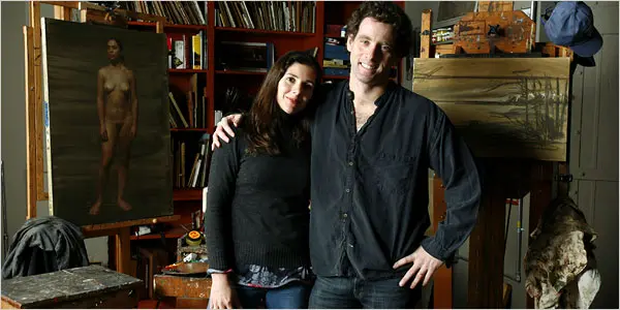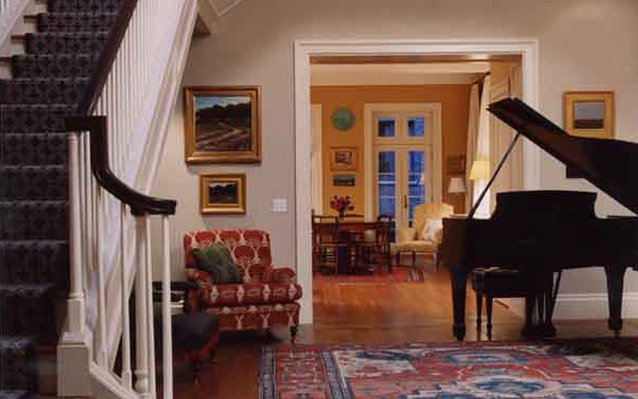New York Times "Art Above and Below, With Life in the Middle"

AT HOME WITH ANN BRASHARES AND JACOB COLLINS
Art Above and Below, With Life in the Middle
By Fred A. Bernstein
Jan. 4, 2007
Photo: Bruce Buck for The New York Times
POST PANTS Ann Brashares, who is publishing the last of her "Sisterhood of the Traveling Pants" books next week, is now writing for adults. With her husband, the painter Jacob Collins, in their East Side carriage house. Bruce Buck for The New York Times
IT has been more than five years since the first of Ann Brashares’s “Sisterhood of the Traveling Pants” novels, which would become a sensation among teenage girls, hit the best-seller list. The last book in the series, “Forever in Blue: The Fourth Summer of the Sisterhood,” will be published on Tuesday, but during that half-decade, the characters have aged only about three years.
To anyone who knows Ms. Brashares and her husband, Jacob Collins, a portrait painter, that lag makes perfect sense. Mr. Collins, too, seems to slow time to suit his purposes: He paints in the classical tradition, using centuries-old techniques to create works that could have been produced hundreds of years ago.
His style is so out, it may be in again. As the ringleader of a group of youngish painters devoted to classical techniques, Mr. Collins was recently named one of the art world’s most powerful people by Art & Auction magazine, and lately, his paintings have been selling for as much as $125,000. Writing about him, the magazine noted that “although many attempts to buck modernism’s strong attraction, only the truly powerful — and talented — can pull it off.”
Mr. Collins, 42, runs a school of classical painting, called the Water Street Atelier, out of the house he and Ms. Brashares, 39, share with their three children, Susannah, 5, Nate, 8, and Sam, 11. Students — about a dozen at a time — spend four years studying with Mr. Collins, working long hours that begin when the first model begins posing at 8:30 each morning. The students sometimes share meals with the family, walk the dog and babysit for the children. And the children occasionally pose in the studio, usually while watching videos, a not-very-classical technique to help them sit still.
For years the couple tried to accommodate both their growing family and Mr. Collins’s studio and art school in a Brooklyn brownstone, while Ms. Brashares worked as an editor at 17th Street Productions, a packager of teen novels. At one point, with the me?nage bursting at the seams, Mr. Collins rented a studio in Dumbo. But in 2000, the couple began looking for a building big enough to accommodate both home and studio, with separate entrances. “We were pretty flexible about geography because the requirements for the building were so specific,” Ms. Brashares said.
A broker directed them to a four-story building in the East 60s that had been built as a carriage house but for years had housed the Sculpture Center, a school and gallery. Essentially an industrial space — the sculptors had been using it for welding and stone-carving — it had no living quarters at all, which is why it was a bargain, the couple said (although they declined to say how much they paid for it). They had profited from the sale of their Brooklyn house and had enjoyed “a small windfall” when 17th Street, of which Ms. Brashares was a part-owner, was sold. Still, they said, they borrowed to the hilt to buy the building.
They hired Fairfax & Sammons, a Manhattan firm known for classical architecture, to renovate the 25-foot-wide, 100-foot-deep building. Richard Sammons, a partner in the firm, began by leaving the ground floor studio pretty much as he found it, with 15-foot ceilings and a black terrazzo floor. (It is so big that the couple can park their car inside without disturbing the students.) On the upper levels, about 4,000 square feet in all, Mr. Sammons created new interiors that look as if they had been there forever, thanks to features like leaded-glass windows.
The architectural details are far less lavish than in many Fairfax & Sammons houses, like a grandiose 60,000-square-foot mansion that the firm is currently completing in Palm Beach. At around $500 a square foot for construction, Mr. Collins said, “our budget was too low” for ostentation. The house’s beauty lies in its proportions. The kitchen is nearly a perfect square, as is the library, with the result that you feel properly situated the moment you walk into either room.
The layout, though, is far from traditional. First, the couple asked Mr. Sammons to dispense with a dining room. Ms. Brashares, who grew up with three brothers and no sisters in a series of houses around Washington, D.C., said, “We always had a big dining room that nobody went into.” Instead, Mr. Sammons turned the back of the house into a 25- by-25-foot kitchen, with multiple work areas for adults and children. In the library at the front of the house, several shelves are filled with candy-colored foreign editions of the “Traveling Pants” books, in more than 30 languages. A stair in the large central hall leads to an upper level with four bedrooms. From there, another stairway ascends to Ms. Brashares’s office, alone on the top floor, her haven.
“I’m careful not to bring household stuff up there,” she said. “I arrange
the playdates in the kitchen; I pay the bills in the kitchen.” She writes,
mostly at night, on a tiny laptop, surrounded by several of Mr. Collins’
paintings — just a few of the more than 100 of his older works that cover
the walls of the house.
Ms. Brashares and Mr. Collins met when she was just 18. At the time, he was a junior at Columbia, and she was a freshman at Barnard; his father, Arthur Collins, was one of her philosophy professors. During their first encounter, in the library, he sketched her portrait.
In the early years of their marriage, Ms. Brashares worked as an editorial assistant, and then an editor, while Mr. Collins, who had attended the New York Academy of Art, honed his technique. In 1999, after hearing a colleague describe how she had once shared a pair of pants with friends, Ms. Brashares began working on a book about four teenage girlfriends who spend their summers apart but stay in touch in part by taking turns wearing the same magical jeans, which somehow fit each of their bodies.
Published in September 2001, “Traveling Pants” was an immediate success. There are now 7 million copies of the books in print in North America alone, according to Noreen Marchisi, a spokeswoman for Random House, Ms. Brashares’s publisher. (This despite the fact that Ms. Brashares tells parents not to buy the books for children under 12, who she thinks may not be ready for the mild sexual content.)
She has just completed her first novel for adults, about a group of friends in their early 20’s, called “The Last Summer (of You & Me).” It will be published in June. She decided to end the “Traveling Pants” series with the latest book, ensuring through a plot twist that the series cannot be revived (though “it’s not like I kill off any of the characters,” she said).
Although she could easily have extended the series, and the considerable
income it generated, Ms. Brashares said that she was “ready to move on.”
In any case, she added, all that money came too late to contribute to the
high cost of the house and its renovation, beyond a few antiques and a
“somewhat old rug” for the center hall.
“I remember thinking: I wish I’d known the book would succeed because I would have tiled our bathroom,” she said.


